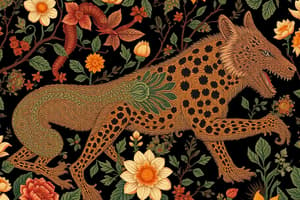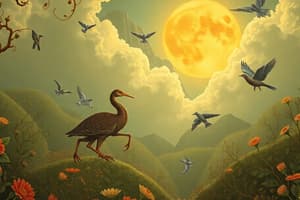Podcast
Questions and Answers
Who was Darwin and what was his mechanism for evolution?
Who was Darwin and what was his mechanism for evolution?
Darwin was a 19th-century naturalist on the HMS Beagle who studied animals. His mechanism for evolution was that species are related by common descent and adaptation to environments results in diversity.
Who was Lamarck and what were his ideas on evolution?
Who was Lamarck and what were his ideas on evolution?
Lamarck was the first scientist to accept the theory of evolution. He proposed that complex organisms derived from less complex ones and believed in the inheritance of acquired characteristics.
What are homologous structures?
What are homologous structures?
- Structures that serve the same function but with different origins
- Similar in structure but not from a common ancestor
- All structures in an organism
- Common organ or bone in different animals showing descent from a common ancestor (correct)
What are vestigial structures?
What are vestigial structures?
What is artificial selection?
What is artificial selection?
What conditions must be met to keep Hardy-Weinberg equilibrium?
What conditions must be met to keep Hardy-Weinberg equilibrium?
What evidence for evolution did Darwin not consider?
What evidence for evolution did Darwin not consider?
What is natural selection?
What is natural selection?
If two fossils are found to be similar but not identical, what type of evidence could be used to determine their relatedness?
If two fossils are found to be similar but not identical, what type of evidence could be used to determine their relatedness?
What is biogeography?
What is biogeography?
What are transitional forms in the fossil record?
What are transitional forms in the fossil record?
Who was Cuvier and what were his thoughts on comparative anatomy?
Who was Cuvier and what were his thoughts on comparative anatomy?
Will the cutting off of mice tails eventually lead to shorter tails?
Will the cutting off of mice tails eventually lead to shorter tails?
What is directional selection?
What is directional selection?
What is stabilizing selection?
What is stabilizing selection?
What is disruptive selection?
What is disruptive selection?
What is a gene pool?
What is a gene pool?
What is genetic drift?
What is genetic drift?
What is gene flow?
What is gene flow?
What is the founder effect?
What is the founder effect?
What is microevolution?
What is microevolution?
What is speciation?
What is speciation?
Flashcards
Natural Selection
Natural Selection
Organisms better adapted to their environment are more likely to survive and reproduce, leading to changes in populations over time.
Common Descent
Common Descent
The idea that all living things share a common ancestor.
Homologous Structures
Homologous Structures
Similar structures in different species that share a common ancestor, even if they have different functions.
Analogous Structures
Analogous Structures
Signup and view all the flashcards
Vestigial Structures
Vestigial Structures
Signup and view all the flashcards
Artificial Selection
Artificial Selection
Signup and view all the flashcards
Directional Selection
Directional Selection
Signup and view all the flashcards
Stabilizing Selection
Stabilizing Selection
Signup and view all the flashcards
Disruptive Selection
Disruptive Selection
Signup and view all the flashcards
Hardy-Weinberg Equilibrium
Hardy-Weinberg Equilibrium
Signup and view all the flashcards
Gene Pool
Gene Pool
Signup and view all the flashcards
Genetic Drift
Genetic Drift
Signup and view all the flashcards
Gene Flow
Gene Flow
Signup and view all the flashcards
Founder Effect
Founder Effect
Signup and view all the flashcards
Microevolution
Microevolution
Signup and view all the flashcards
Speciation
Speciation
Signup and view all the flashcards
Allopatric Speciation
Allopatric Speciation
Signup and view all the flashcards
Sympatric Speciation
Sympatric Speciation
Signup and view all the flashcards
Transitional Fossils
Transitional Fossils
Signup and view all the flashcards
Study Notes
Darwin and Evolution
- Charles Darwin was a 19th-century naturalist known for his studies aboard the HMS Beagle.
- Proposed that species are related through common descent with natural variation leading to adaptation and diversity.
Lamarck's Ideas
- Jean-Baptiste Lamarck was the first scientist to advocate for the theory of evolution.
- Believed complex organisms evolved from simpler ones and introduced the concept of inheritance of acquired characteristics.
Structural Comparison
- Homologous structures are anatomical features that share a common ancestry despite possible functional differences.
- Analogous structures have similar functions but do not share a common ancestor.
Vestigial Structures
- Vestigial structures are remnants of organs or genes that no longer serve a functional purpose.
- Provide evidence of common ancestry as these structures were once functional in ancestral species.
Selection Mechanisms
- Artificial selection refers to the human-directed breeding of organisms for desired traits.
- Natural selection involves variations within species, competition, differential fitness, and adaptation to environments.
Hardy-Weinberg Equilibrium
- Hardy-Weinberg principle states allele frequencies remain constant in a population under specific conditions: no mutations, extensive gene flow, random mating, no genetic drift, and no selection.
Limitations of Darwin's Work
- Darwin could not consider molecular evidence for evolution due to the lack of technology for analyzing amino acid differences.
Natural Selection
- Defined as "survival of the fittest," it favors organisms best adapted to their environment.
Fossil Evidence
- Biochemical evidence, such as comparing amino acid sequences, can be utilized to ascertain relatedness between similar but not identical fossils.
Biogeography
- The study of the geographical distribution and range of species, providing insights into evolutionary relationships.
Transitional Forms
- Archaeopteryx serves as a transitional fossil linking dinosaurs to birds, illustrating the evolution of species.
Cuvier and Comparative Anatomy
- Georges Cuvier was a 19th-century zoologist and the founder of paleontology, advocating catastrophism as an explanation for the sudden appearance of new species in the fossil record.
Inheritance of Traits
- The idea that cutting off mice tails could lead to shorter tails in offspring stems from Lamarck's theory, which is now known to be incorrect.
Selection Types
- Directional selection favors extreme phenotypes, shifting population traits in that direction.
- Stabilizing selection favors intermediate phenotypes, leading to less variation.
- Disruptive selection favors two or more extreme phenotypes over intermediates.
Population Genetics
- A gene pool consists of all the genes and alleles present in a population.
- Genetic drift describes fluctuations in allele frequencies resulting from random sampling effects.
Gene Flow
- Involves the transfer of alleles into or out of a population, often through migration.
Founder Effect
- Occurs when a small group establishes a new population, leading to reduced genetic diversity and prevalence of certain alleles.
Microevolution
- Refers to small evolutionary changes within a population, often in contrast to the expectations set by Hardy-Weinberg equilibrium.
Speciation
- Speciation is the formation of new species due to reproductive isolation.
- Allopatric speciation results from geographic isolation, while sympatric speciation occurs without physical barriers.
Studying That Suits You
Use AI to generate personalized quizzes and flashcards to suit your learning preferences.




